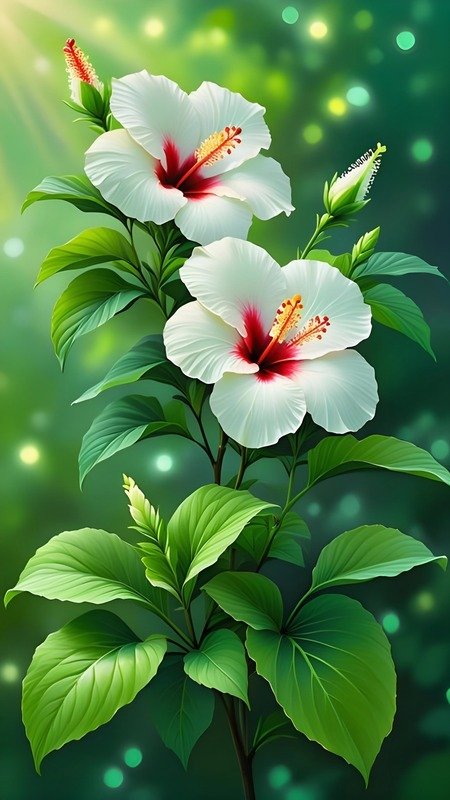Explore the beauty of the White Hibiscus Plant! Learn expert tips on planting, pruning and maintaining this tropical beauty to enjoy its stunning blooms year-round.
The White Hibiscus Plant is a breathtaking addition to any garden, known for its large, stunning flowers and lush foliage. In this comprehensive guide, I’ll share my expertise on how to grow, care for and maintain this beautiful plant, ensuring it flourishes in your landscape.
Here’s an easy-to-read chart for the White Hibiscus plant:
| Category | Details |
|---|---|
| Botanical Name | Hibiscus rosa-sinensis |
| Common Name | White Hibiscus |
| Plant Type | Deciduous shrub |
| Hardiness Zone | 9-11 |
| Sun Exposure | Full sun |
| Soil Type | Well-draining, loamy |
| Watering | Regularly; keep soil moist but not soggy |
| Growth Habit | Upright and bushy |
| Height/Spread | 4-10 feet tall / 3-6 feet wide |
| Special Features | Attractive large flowers, attracts pollinators, drought-tolerant once established |
Introduction to the White Hibiscus Plant

As an experienced horticulturist, I can confidently say that the White Hibiscus Plant (Hibiscus rosa-sinensis) is one of the most captivating tropical plants you can grow. Its striking white blooms and lush green leaves create a tropical paradise in any garden, and it thrives in various climates.
Why Choose the White Hibiscus Plant?
- Beautiful Blooms: The large, showy white flowers are not only visually stunning but can also reach up to 6 inches in diameter.
- Versatile Growth: It can be grown in the ground or as a potted plant, making it perfect for gardens, patios, and balconies.
- Attracts Pollinators: This plant is a magnet for bees and butterflies, adding life and color to your garden.
Understanding the White Hibiscus Plant
Botanical Information
- Scientific Name: Hibiscus rosa-sinensis
- Family: Malvaceae
- Type: Tropical flowering shrub
This hibiscus is recognized for its distinctive, trumpet-shaped flowers that bloom throughout the year, particularly in warmer climates.
Growing the White Hibiscus Plant
Choosing the Right Location
- Light Requirements: The White Hibiscus thrives in full sun, requiring at least 6-8 hours of direct sunlight daily for optimal blooming.
- Soil Requirements: It prefers well-draining, loamy soil enriched with organic matter.
Planting Process
- Timing: The best time to plant is in spring after the last frost or in early fall.
- Spacing: Space plants about 3-4 feet apart to allow for their bushy growth habit.
- Planting Depth: Dig a hole deep enough to accommodate the root ball, ensuring it is planted at the same level as it was in the container.
For detailed planting instructions, check out the American Society for Horticultural Science.
Caring for the White Hibiscus Plant
Watering
- Watering Schedule: Water deeply and regularly, especially during dry spells. The soil should remain consistently moist but not soggy.
- Mulching: Apply a layer of mulch around the base to help retain moisture and suppress weeds.
Fertilizing
- Fertilizer Type: Use a balanced, slow-release fertilizer formulated for flowering plants in early spring. Reapply every 6-8 weeks during the growing season to promote healthy growth and blooms.
Pruning
- Pruning Schedule: Prune in late winter or early spring before new growth begins. Remove any dead or damaged branches and shape the plant as needed.
- Techniques: Focus on thinning out crowded areas to improve air circulation and encourage bushier growth.
Pest and Disease Management
Common Pests
- Aphids: Use insecticidal soap or neem oil to control aphid populations.
- Whiteflies: Implement yellow sticky traps or insecticidal soap to manage infestations.
Diseases
- Leaf Spot: Prevent this fungal disease by ensuring good air circulation and avoiding overhead watering. Treat with a fungicide if necessary.
For more information on pest and disease management, visit Purdue University Extension.
Landscape Uses
The White Hibiscus Plant is versatile in landscaping:
- Garden Borders: Ideal for planting along garden borders or as a backdrop for smaller plants.
- Accent Plant: Use it as a focal point in your garden due to its stunning blooms.
- Tropical Gardens: Perfect for creating a tropical or exotic garden theme.
Environmental Benefits
The White Hibiscus Plant offers several ecological benefits:
- Pollinator Support: Attracts bees, butterflies, and hummingbirds, promoting biodiversity in your garden.
- Erosion Control: Its deep roots help stabilize soil and prevent erosion in garden beds.
Learn more about the benefits of flowering plants in the garden from the National Wildlife Federation.
The White Hibiscus Plant is a beautiful and rewarding addition to any landscape, providing stunning blooms and lush foliage throughout the growing season. With proper care, including adequate sunlight, well-draining soil, and regular maintenance, you can enjoy this gorgeous plant in your garden for years to come.
For more information on hibiscus care and gardening tips, visit Fine Gardening.